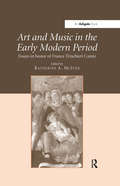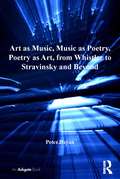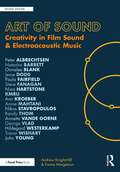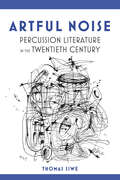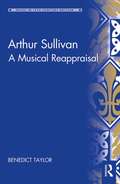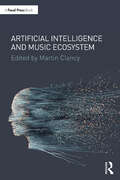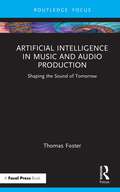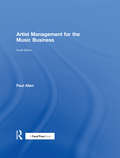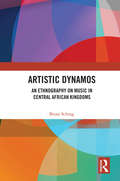- Table View
- List View
Ars antiqua: Organum, Conductus, Motet (Music In Medieval Europe Ser.)
by Edward H. RoesnerThe ars antiqua began to be mentioned in writings about music in the early decades of the fourteenth century, where it was cited along with references to a more modern "art", an ars nova. It was understood by those who coined the notion to be rooted in the musical practices outlined in the Ars musica of Lambertus and, especially, the Ars cantus mensurabilis of Franco of Cologne. Directly or indirectly the essays collected in this volume all address one or more of the issues regarding ars antiqua polyphony-questions relating to the nature and definition of genre; the evolution of the polyphonic idiom; the workings of the creative process including the role of oral process and notation and the continuum between these extremes; questions about how this music was used and understood; and of how it fits into the intellectual life of the twelfth and thirteenth centuries. Some of the essays ask new questions or approach long-standing ones from fresh perspectives. All, however, are rooted in a line of scholarship that produced a body of writing of continuing relevance.
Ars nova: French and Italian Music in the Fourteenth Century (Music In Medieval Europe Ser.)
by John L. Nádas Michael Scott CuthbertIn the early fourteenth century, musicians in France and later Italy established new traditions of secular and sacred polyphony. This ars nova, or "new art," popularized by theorists such as Philippe de Vitry and Johannes de Muris was the among the first of many later movements to establish the music of the present as a clean break from the past. The rich music of this period, by composers such as Guillaume de Machaut and Francesco Landini, is not only beautiful, but also rewards deep study and analysis. Yet contradictions and gaps abound in the ars nova of the fourteenth and early fifteenth centuries-how do we read this music? how do we perform this music? what was the cultural context of these performances? These problems are well met by the ingenuity of approaches and solutions found by scholars in this volume. The twenty-seven articles brought together reflect the broad methodological and chronological range of scholarly inquiry on the ars nova.
Art Chantry Speaks
by Art Chantry Monica René RochesterThere used to be a time when designers were trained in the history of composition. Now you just buy a fuckin' piece of software and now you've become a designer."Art Chantry . . . Is he a Luddite?" asks a Rhode Island School of Design poster promoting a Chantry lecture. "Or is he a graphic design hero?"For decades this avatar of low-tech design has fought against the cheap and easy use of digital software. Chantry's homage to expired technology, and his inspired use of Xerox machines and X-Acto blade cuts of printed material, created a much-copied style during the grunge period and beyond.Chantry's designs were published in Some People Can't Surf: The Graphic Design of Art Chantry (Chronicle Books), exhibited at the Seattle Art Museum, the Rock and Roll Hall of Fame, the Museum of Modern Art, the Smithsonian, and the Louvre.More recently, Chantry has drawn upon his extraordinary collection of twentieth-century graphic art to create compelling histories of the forgotten and unknown on essays he has posted on his Facebook page. These essays might lionize the unrecognized illustrators of screws, wrenches, and pipes in equipment catalogs. Other posts might reveal how some famous artists were improperly recognized.Art Chantry Speaks is the kind of opinionated art history you've always wanted to read but were never assigned.
Art Into Pop (Routledge Library Editions: Popular Music #2)
by Simon Frith Howard HorneThis book, first published in 1987, tells the intriguing and culturally complex story of the art school influence on postwar British popular music. Following Romantic attitudes from life class to recording studio, it focuses on two key moments – the early 1960s, when art students like John Lennon and Eric Clapton begin to play their own versions of American rock and blues and inflected youth music with Bohemian dreams, and the late 1970s, when punk musicians emerged from design courses and fashion departments to disrupt what were, by then, art-rock routines. Sixties rock Bohemians and seventies pop Situationists were, in their different ways, trying to solve the art students’ perennial problem – how to make a living from their art. Art Into Pop shows how this problem has been shaped by the history of British art education, from its nineteenth-century origins to current arguments about ‘pure’ and ‘applied’ training. In their simultaneous pursuit of authenticity and artifice, art school musicians exemplify the postmodern condition, the collapse of any distinction between ‘high’ and ‘low’ culture, the confusions of personal and commercial creativity. And so high pop theorists rub shoulders here with low pop practitioners, experimental musicians debate avant-garde ideas with corporate packagers, and artistic integrity becomes a matter of making oneself up.
Art Music Activism: Aesthetics and Politics in 1930s New York City (Music in American Life)
by Maria Cristina FavaSurrounded by the widespread misery of the Depression, left-leaning classical music composers sought a musical language that both engaged the masses and gave voice to their concerns. Maria Cristina Fava explores the rich creative milieu shaped by artists dedicated to using music and theater to advance the promotion, circulation, and acceptance of leftist ideas in 1930s New York City. Despite tensions between aesthetic and pragmatic goals, the people and groups produced works at the center of the decade’s sociopolitical and cultural life. Fava looks at the Composers’ Collective of New York and its work on proletarian music and workers’ songs before turning to the blend of experimentation and vernacular idioms that shaped the political use of music within the American Worker’s Theater Movement. Fava then reveals how composers and theater practitioners from these two groups achieved prominence within endeavors promoted by the Works Project Administration. Fava’s history teases out fascinating details from performances and offstage activity attached to works by composers such as Marc Blitzstein, Charles Seeger, Ruth Crawford Seeger, Elie Siegmeister, and Harold Rome. Endeavors encouraged avant-garde experimentation while nurturing innovations friendly to modernist approaches and an interest in non-western music. Blitzstein’s The Cradle Will Rock offered a memorable example that found popular success, but while the piece achieved its goals, it became so wrapped up in myths surrounding workers’ theater that critics overlooked Blitzstein’s musical ingenuity. Provocative and original, Art Music Activism considers how innovative classical composers of the 1930s balanced creative aims with experimentation, accessible content, and a sociopolitical message to create socially meaningful works.
Art Music: Love, Listening and Soulfulness
by Matthew Del NevoListening to music is not merely something one does, but something central to a way of living. Listening has the power to transport one into another way of being. It is a mode of feeling and forms the bedrock of deep emotion. Written from the viewpoint of a philosophy of sensibility, Matthew Del Nevo notes that this perspective may not be in fashion, but it follows a long tradition.Del Nevo emphasizes the aesthetic experience of listening to art music as it has developed and disintegrated in Western civilization. He recognizes a deep psychological element to what he calls soul—or more accurately sensibility. He addresses music in a non-technical way, taking up the powerful art theory of Charles Baudelaire, the music philosophy of Schopenhauer and Richard Wagner, and takes a strong critical stand against modernist intellectual art music.The importance of this book for the musically- literate reader is its insight into the metaphysics of nostalgia. This comprehension is missing from nearly all musical instruction because we have lost sight of it. Del Nevo asserts that this understanding must be brought back into our culture. And since this is a book about listening to art music, it is no less about sensibility and its cultivation, which in its object form we call culture. An engaging book, Art Music will appeal to those interested in music, culture, and philosophy.
Art Rebels: Race, Class, and Gender in the Art of Miles Davis and Martin Scorsese
by Paul LopesHow creative freedom, race, class, and gender shaped the rebellion of two visionary artistsPostwar America experienced an unprecedented flourishing of avant-garde and independent art. Across the arts, artists rebelled against traditional conventions, embracing a commitment to creative autonomy and personal vision never before witnessed in the United States. Paul Lopes calls this the Heroic Age of American Art, and identifies two artists—Miles Davis and Martin Scorsese—as two of its leading icons.In this compelling book, Lopes tells the story of how a pair of talented and outspoken art rebels defied prevailing conventions to elevate American jazz and film to unimagined critical heights. During the Heroic Age of American Art—where creative independence and the unrelenting pressures of success were constantly at odds—Davis and Scorsese became influential figures with such modern classics as Kind of Blue and Raging Bull. Their careers also reflected the conflicting ideals of, and contentious debates concerning, avant-garde and independent art during this period. In examining their art and public stories, Lopes also shows how their rebellions as artists were intimately linked to their racial and ethnic identities and how both artists adopted hypermasculine ideologies that exposed the problematic intersection of gender with their racial and ethnic identities as iconic art rebels.Art Rebels is the essential account of a new breed of artists who left an indelible mark on American culture in the second half of the twentieth century. It is an unforgettable portrait of two iconic artists who exemplified the complex interplay of the quest for artistic autonomy and the expression of social identity during the Heroic Age of American Art.
Art and Music in the Early Modern Period: Essays in Honor of Franca Trinchieri Camiz
by Katherine A. McIverThe relationship between music and painting in the Early Modern period is the focus of this collection of essays by an international group of distinguished art historians and musicologists. Each writer takes a multidisciplinary approach as he or she explores the interface between music performance and painting, or between music and art theory. The essays reflect a variety and range of approaches and offer methodologies which might usefully be employed in future research in this field. The volume is dedicated to the memory of Franca Trinchieri Camiz, an art historian who worked extensively on topics related to art and music, and who participated in some of the conference panels from which many of these essays originate. Three of Professor Camiz's own essays are included in the final section of this volume, together with a bibliography of her writings in this field. They are preceded by two thematic groups of essays covering aspects of musical imagery in portraits, issues in iconography and theory, and the relationship between music and art in religious imagery.
Art as Music, Music as Poetry, Poetry as Art, from Whistler to Stravinsky and Beyond
by Peter DayanIn 1877, Ruskin accused Whistler of ’flinging a pot of paint in the public’s face’. Was he right? After all, Whistler always denied that the true function of art was to represent anything. If a painting does not represent, what is it, other than mere paint, flung in the public’s face? Whistler’s answer was simple: painting is music - or it is poetry. Georges Braque, half a century later, echoed Whistler’s answer. So did Braque’s friends Apollinaire and Ponge. They presented their poetry as music too - and as painting. But meanwhile, composers such as Satie and Stravinsky were presenting their own art - music - as if it transposed the values of painting or of poetry. The fundamental principle of this intermedial aesthetic, which bound together an extraordinary fraternity of artists in all media in Paris, from 1885 to 1945, was this: we must always think about the value of a work of art, not within the logic of its own medium, but as if it transposed the value of art in another medium. Peter Dayan traces the history of this principle: how it created our very notion of ’great art’, why it declined as a vision from the 1960s and how, in the 21st century, it is fighting back.
Art of Sound: Creativity in Film Sound and Electroacoustic Music (Sound Design)
by Andrew Knight-Hill Emma MargetsonBringing together a diverse group of world leading professionals across Post-Production Film Sound and Electroacoustic Music, Art of Sound explores the creative principles that underpin how sonic practitioners act to compose, tell stories, make us feel, and communicate via sound. Revealing new understandings through analysis of interdisciplinary exchanges and interviews, this book investigates questions of aesthetics, perception, and interpretation, unveiling opportunities for a greater appreciation of the artistry in sound practice which underpins both experimental electronic music and the world’s leading film and television productions. It argues that we can better understand and appreciate the creative act if we regard it as a constantly unfolding process of inspiration, material action, and reflection. In contrast to traditional notions, which imagine outputs as developed to reflect a preconceived creative vision, our approach recognises that the output is always emerging as the practitioner flows with their materials in search of their solution, constantly negotiating the rich networks of potential. This enables us to better celebrate the reality of the creative process, de-centring technologies and universal rules, and potentially opening up the ways in which we think about sonic practices to embrace more diverse ideas and approaches. Art of Sound provides insight into the latest developments and approaches to sound and image practice for composers, filmmakers, directors, scholars, producers, sound designers, sound editors, sound mixers, and students who are interested in understanding the creative potential of sound.
Art of Suppression: Confronting the Nazi Past in Histories of the Visual and Performing Arts (Weimar and Now: German Cultural Criticism)
by Pamela M. PotterThis provocative study asks why we have held on to vivid images of the Nazis’ total control of the visual and performing arts, even though research has shown that many artists and their works thrived under Hitler. To answer this question, Pamela M. Potter investigates how historians since 1945 have written about music, art, architecture, theater, film, and dance in Nazi Germany and how their accounts have been colored by politics of the Cold War, the fall of communism, and the wish to preserve the idea that true art and politics cannot mix. Potter maintains that although the persecution of Jewish artists and other "enemies of the state" was a high priority for the Third Reich, removing them from German cultural life did not eradicate their artistic legacies. Art of Suppression examines the cultural histories of Nazi Germany to help us understand how the circumstances of exile, the Allied occupation, the Cold War, and the complex meanings of modernism have sustained a distorted and problematic characterization of cultural life during the Third Reich.
Art, Cybernetics and Pedagogy in Post-War Britain: Roy Ascott’s Groundcourse (Routledge Advances in Art and Visual Studies)
by Kate SloanThis is the first full-length study about the British artist Roy Ascott, one of the first cybernetic artists, with a career spanning seven decades to date. The book focuses on his early career, exploring the evolution of his early interests in communication in the context of the rich overlaps between art, science and engineering in Britain during the 1950s and 1960s. The first part of the book looks at Ascott’s training and early work. The second park looks solely at Groundcourse, Ascott’s extraordinary pedagogical model for visual arts and cybernetics which used an integrative and systems-based model, drawing in behaviourism, analogue machines, performance and games. Using hitherto unpublished photographs and documents, this book will establish a more prominent place for cybernetics in post-war British art.
Art, Music, and Literature, 1897-1902
by Theodore DreiserDreiser's captivating portraits of turn-of-the-century America's famous figures In this volume, liberally seasoned with period illustrations, Yoshinobu Hakutani has collected and annotated a rich selection of Theodore Dreiser's pre-fame writings on the cultural milieu of his day. In these brief essays, Dreiser sallies into the vibrant world of creative work in turn-of-the-century America. He inspects the eccentric and revealing paraphernalia of artists' studios, probes the work habits of writers, and goes behind the scenes in the popular song-writing business, where this week's celebrity is next week's has-been. He profiles famous figures and introduces numerous women artists, novelists, and musicians, including the prolific and tireless Amelia Barr (mother of fourteen children and author of thirty-two novels), the illustrator Alice B. Stephens, and the opera singer Lillian Nordica. Hakutani's notes provide biographical detail on dozens of now-obscure individuals mentioned by Dreiser.
Art, Music, and Mysticism at the Fin de Siècle: Seeing and Hearing the Beyond (Routledge Research in Art History)
by Michelle Foot Corrinne ChongThis edited volume explores the dialogue between art and music with that of mystical currents at the turn of the twentieth century. The volume draws on the most current research from both art historians and musicologists to present an interdisciplinary approach to the study of mysticism’s historical importance. The chapters in this edited volume gauge the scope of different interpretations of mysticism and illuminate how an exchange between the sister arts unveil an underlying stream of metaphysical, supernatural, and spiritual ideas over the course of the century. Case studies include Charles Tournemire, Joseph Péladan, Erik Satie, Hilma af Klint, Jean Sibelius, František Kupka, and Wassily Kandinsky. The contributors’ unique theoretical perspectives and disciplinary methodologies offer expert insight on both the rewards and inevitable aesthetic complications that arise when one artform meets another. The book will be of interest to scholars working in art history, musicology, visual culture, and mysticism.
Artania: El grito de los faraones
by Laurie Woodward Pilar Ordaz B.Bartholomew, de once años, no puede ir a la escuela, jugar afuera o, lo peor de todo, hacer arte – así que dibuja en secreto. Después de que conoce a un pintor en patineta, Alexander DeVinci, ambos son transportados a otro reino de pinturas mágicas. Su propio mundo es muy diferente en comparación con Artania: un mundo con pinturas y esculturas vivientes. Pronto aprenden que Artania está al filo de la destrucción, y el arte de Bartholomew es la única cosa que puede salvarle. Tanto con dioses como diosas a su lado, Bartholomew se enfrenta a batallas, duelos y escapes sobre patinetas. Pero incluso con sus poderes creciendo, ¿puede él derrotar el ejército malévolo de Sickhert y traer el arte de vuelta al mundo?
Artania: L'urlo del Faraone
by Laurie WoodwardL’undicenne Bartolomeo non può andare a scuola né giocare all’aperto e, cosa peggiore di tutte, non può fare arte; così disegna in segreto. Dopo aver incontrato il pittore-skater Alexander DeVinci, i due ragazzi vengono catapultati in un altro regno grazie ad un dipinto magico. Il loro mondo reale è molto diverso se comparato ad Artania: un mondo in cui le sculture e i dipinti prendono vita. Ben presto i due ragazzi apprenderanno che Artania è sull’orlo della distruzione, e solo l’arte di Bartolomeo potrà salvare questo mondo. Con le divinità egizie dalla sua parte, Bartolomeo affronterà battaglie, duelli e fughe sullo skateboard. Ma sebbene i suoi poteri siano aumentati, riuscirà a sconfiggere l’armata di Malcuore e riportare l’arte nel mondo?
Artful Noise: Percussion Literature in the Twentieth Century (Music in American Life #502)
by Thomas SiweTwentieth-century composers created thousands of original works for solo percussion and percussion ensemble. Concise and ideal for the classroom, Artful Noise offers an essential and much-needed survey of this unique literature. Percussionist Thomas Siwe organizes and analyzes the groundbreaking musical literature that arose during the twentieth century. Focusing on innovations in style and the evolution of the percussion ensemble, Siwe offers a historical overview that connects the music to scoring techniques, new instrumentation and evolving technologies as well as world events. Discussions of representative pieces by seminal composers examines the resources a work requires, its construction, and how it relates to other styles that developed during the same period. In addition, Siwe details the form and purpose of many of the compositions while providing background information on noteworthy artists. Each chapter is supported with musical examples and concludes with a short list of related works specifically designed to steer musicians and instructors alike toward profitable explorations of composers, styles, and eras.
Arthur Sullivan: A Musical Reappraisal (Music in Nineteenth-Century Britain)
by Benedict TaylorArthur Sullivan (1842–1900) was Victorian Britain’s most celebrated and popular composer, whose music to this day reaches a wider audience than that of any of his contemporaries. Yet the comic operas on which Sullivan’s reputation is chiefly based have been consistently belittled or ignored by the British musicological establishment, while his serious works have until recently remained virtually unknown. The time is thus long overdue for scholarly re-engagement with Sullivan. The present book offers a new appraisal of the music of this most notable nineteenth-century British composer, combining close analytical attention to his music with critical consideration of the wider aesthetic and social context to his work. Focusing on key pieces in all the major genres in which Sullivan composed, it includes accounts of his most important serious works – the music to The Tempest, the ‘Irish’ Symphony, The Golden Legend, Ivanhoe – alongside detailed examination of the celebrated comic operas created with W.S. Gilbert to present a balanced portrayal of Sullivan’s musical achievement.
Artie Shaw, King of the Clarinet: His Life and Times
by Tom Nolan"The two sides of Shaw . . . are at the center of . . . [this] compulsively readable biography."--Daniel Akst, Wall Street Journal During America's Swing Era, no musician was more successful or controversial than Artie Shaw: the charismatic and opinionated clarinetist-bandleader whose dozens of hits became anthems for "the greatest generation." But some of his most beautiful recordings were not issued until decades after he'd left the scene. He broke racial barriers by hiring African American musicians. His frequent "retirements" earned him a reputation as the Hamlet of jazz. And he quit playing for good at the height of his powers. The handsome Shaw had seven wives (including Lana Turner and Ava Gardner). Inveterate reader and author of three books, he befriended the best-known writers of his time. Tom Nolan, who interviewed Shaw between 1990 and his death in 2004 and spoke with one hundred of his colleagues and contemporaries, captures Shaw and his era with candor and sympathy, bringing the master to vivid life and restoring him to his rightful place in jazz history. Originally published in hardcover under the title Three Chords for Beauty's Sake.
Artificial Intelligence and Music Ecosystem
by Martin ClancyArtificial Intelligence and Music Ecosystem highlights the opportunities and rewards associated with the application of AI in the creative arts. Featuring an array of voices, including interviews with Jacques Attali, Holly Herndon and Scott Cohen, this book offers interdisciplinary approaches to pressing ethical and technical questions associated with AI. Considering the perspectives of developers, students and artists, as well as the wider themes of law, ethics and philosophy, Artificial Intelligence and Music Ecosystem is an essential introduction for anyone interested in the impact of AI on music, including those studying and working in the creative arts.
Artificial Intelligence in Music and Audio Production: Shaping the Sound of Tomorrow
by Thomas FosterIn a time when artificial intelligence (AI) is becoming increasingly integrated into music production, Artificial Intelligence in Music and Audio Production provides a comprehensive and easy-to-understand overview of the latest developments.Artificial Intelligence in Music and Audio Production begins by explaining how AI is already being used in various areas of music production today, from composition and sound design to mixing, mastering, and creating music videos. Practical guides and examples show how anyone can benefit from these new technologies. Whether it’s about generating synthetic vocals, transforming your own voice, or creating complete songs using text prompts—the possibilities are almost limitless. Artificial Intelligence in Music and Audio Production demonstrates to musicians and producers how AI can allow musicians and producers to realize their ideas faster and in more comprehensive ways, ultimately enriching their creative process.This book will be of interest to singers, DJs, music producers, and anyone interested in the future of music—even without a deep technical background.
Artist Management for the Music Business
by Paul AllenAnyone managing an artist’s career needs to be well versed and have a savvy understanding of the moving parts of the music business. You’ll learn how and why those moving parts "move," as well as how to manage and navigate a music-based career. Artist Management for the Music Business gives you a comprehensive view of how to generate income through music and how to strategically plan for future growth. The book is full of valuable practical insights. It includes interviews and case studies with examples of real-world management issues and outcomes. Updates to this new edition include the importance of online streaming to music careers, how anyone can effectively network, tools for successful negotiation, ways to identify and manage income sources, and guidance on the ever-changing social media landscape of the music business. This book gives you access to resources about artist management and the music business at its companion website, http://www.artistmanagementonline.com. There is no login, and the resources are updated regularly.
Artist Management for the Music Business: Manage Your Career in Music: Manage the Music Careers of Others
by Paul AllenAnyone managing an artist’s career needs to be well versed and have a savvy understanding of the moving parts of the music business. Learn how and why those moving parts "move," as well as how to manage and navigate a music-based career. Artist Management for the Music Business gives a comprehensive view of how to generate income through music and how to strategically plan for future growth. The book is full of valuable practical insights. It includes interviews and case studies with examples of real-world management issues and outcomes. Updates to this new edition include a new chapter for independent, self-managing artists, expanded and updated sections on networking, social media, and streaming, and a basic introduction to data analytics for the music business. This book gives access to resources about artist management and the music business at its companion website, www.artistmanagementonline.com.
Artistic Dynamos: An Ethnography On Music In Central African Kingdoms
by Brian SchragArtistic Dynamos: An Ethnography on Music in Central African Kingdoms uses stories and research from Ngiemboon communities of West Cameroon as touchstones for proposing new approaches to arts scholarship and community development. Building on the results of ethnographic research, artistic action is viewed through the lens of communication. This view brings a picture of increased cultural energy in the enactment of artistic genres—melodic, rhythmic, poetic, dramatic, visual, and performative. Schrag’s treatise will change how scholars across disciplines understand and engage with the arts. This volume offers methods for improved scholarship, resulting in communities living better lives. The author’s website contains the video and audio recordings discussed in the book, plus full-color versions of many photos and diagrams. www.ArtisticDynamos.com
Artistic Practice as Research in Music: Theory, Criticism, Practice (SEMPRE Studies in The Psychology of Music)
by Mine Dogantan-DackArtistic Practice as Research in Music: Theory, Criticism, Practice brings together internationally renowned scholars and practitioners to explore the cultural, institutional, theoretical, methodological, epistemological, ethical and practical aspects and implications of the rapidly evolving area of artistic research in music. Through various theoretical positions and case studies, and by establishing robust connections between theoretical debates and concrete examples of artistic research projects, the authors discuss the conditions under which artistic practice becomes a research activity; how practice-led research is understood in conservatoire settings; issues of assessment in relation to musical performance as research; methodological possibilities open to music practitioners entering academic environments as researchers; the role of technology in processes of musical composition as research; the role and value of performerly knowledge in music-analytical enquiry; issues in relation to live performance as a research method; artistic collaboration and improvisation as research tools; interdisciplinary concerns of the artist-researcher; and the relationship between the affordances of a musical instrument and artistic research in musical performance. Readers will come away from the book with fresh insights about the theoretical, critical and practical work being done by experts in this exciting new field of enquiry.







